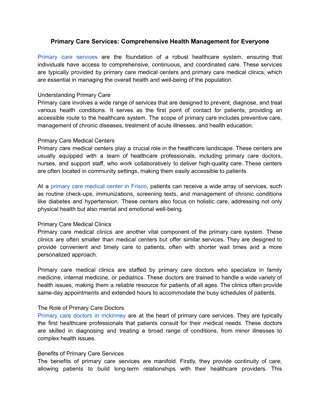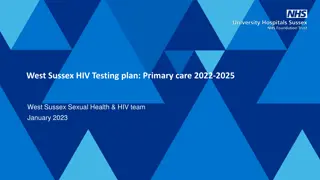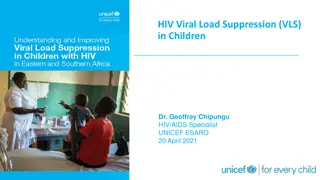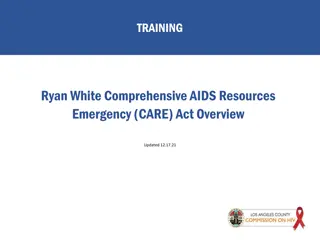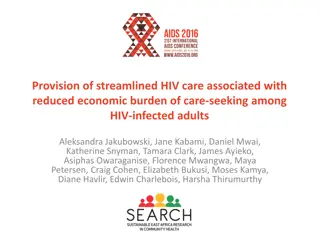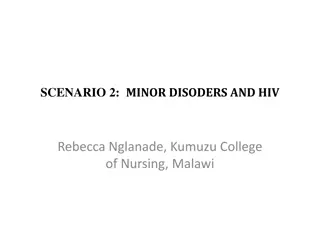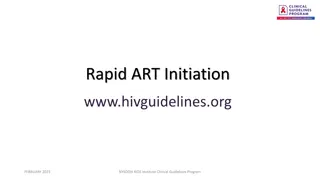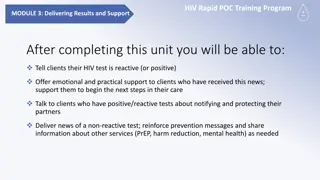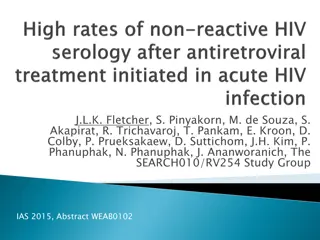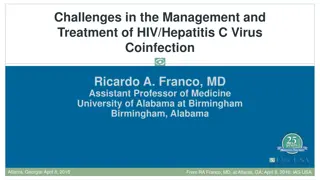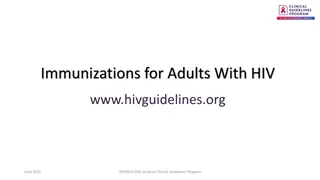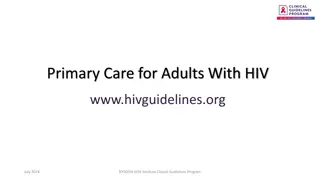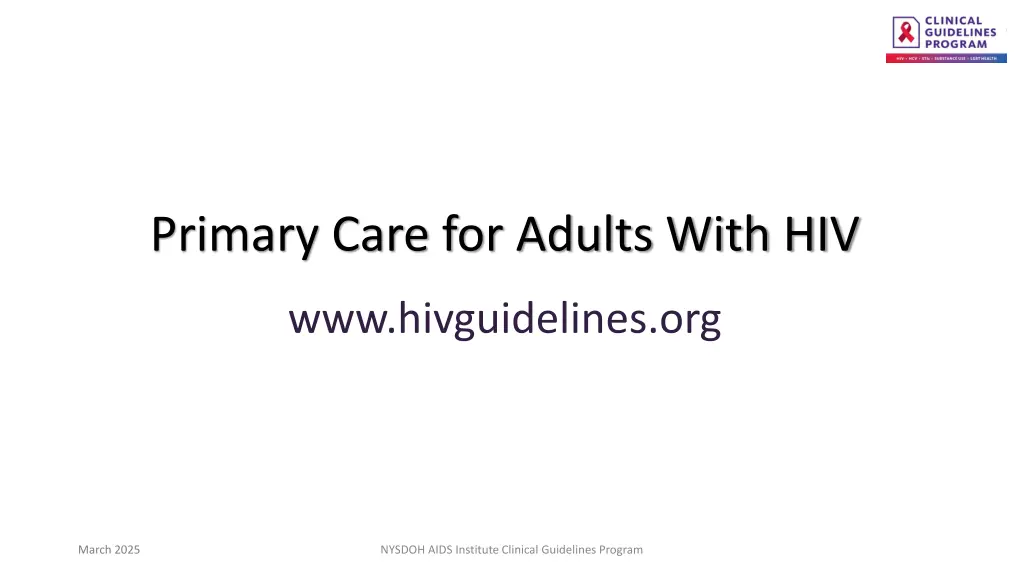
Comprehensive Primary Care Guidelines for Adults with HIV in New York State
Access the March 2025 NYSDOH AIDS Institute Clinical Guidelines Program for providing primary care to adults with HIV in New York State. Learn about assessment, care planning, and follow-up recommendations, as well as HIV-specific care elements to ensure quality treatment. Utilize flowcharts for different patient scenarios, engage in shared decision-making, and understand opportunistic infection prophylaxis practices.
Download Presentation

Please find below an Image/Link to download the presentation.
The content on the website is provided AS IS for your information and personal use only. It may not be sold, licensed, or shared on other websites without obtaining consent from the author. If you encounter any issues during the download, it is possible that the publisher has removed the file from their server.
You are allowed to download the files provided on this website for personal or commercial use, subject to the condition that they are used lawfully. All files are the property of their respective owners.
The content on the website is provided AS IS for your information and personal use only. It may not be sold, licensed, or shared on other websites without obtaining consent from the author.
E N D
Presentation Transcript
Primary Care for Adults With HIV www.hivguidelines.org March 2025 NYSDOH AIDS Institute Clinical Guidelines Program
Purpose of This Guideline Purpose of This Guideline Increasing access to comprehensive primary care in their setting of choice for adults with HIV in New York State. Clarifying that primary care for adults is generally the same for adults with and without HIV, while also clarifying medical care needs particular to adults with HIV. Providing effective tools for all clinicians delivering comprehensive primary care to adults with HIV, including family practice clinicians, internists, and HIV or infectious diseases specialists. March 2025 NYSDOH AIDS Institute Clinical Guidelines Program www.hivguidelines.org
Recommendations Recommendations Approach to Care Based on the type of visit and a patient s diagnostic and HIV status, clinicians should use one of the flowcharts listed below to guide assessment, care planning, and follow-up (A*): Initial Visit: New Patient, New HIV Diagnosis, NOT Taking ART Initial Visit: New Patient, HIV Confirmed, IS Taking ART Initial Visit: New Patient, HIV Confirmed, NOT Taking ART Annual, Routine, New Illness, or Post-Hospitalization Visit: Established Patient Who IS Taking ART Also see the NYSDOH AI Guidance: Addressing the Needs of Older Patients in HIV Care In providing primary care for adults with HIV, clinicians should follow standard best practices for adult primary care and should add the HIV-specific care elements noted in this guideline. (A3) Clinicians should engage patients in shared decision-making regarding routine health screening tests, weighing the risks and benefits of screening based on such factors as life expectancy, cost, potential harms, and HIV-compounded risk. (A3) Opportunistic Infection Prophylaxis Clinicians should initiate prophylaxis for specific OIs and discontinue prophylaxis as indicated in Opportunistic Infection Prophylaxis for Adults With HIV. (A*) Clinicians may discontinue primary OI prophylaxis in patients who are taking effective ART and have evidence of immune recovery. (A*) March 2025 NYSDOH AIDS Institute Clinical Guidelines Program www.hivguidelines.org
Flowchart 1: Initial Visit, New HIV Diagnosis, NOT Taking ART Flowchart 1: Initial Visit, New HIV Diagnosis, NOT Taking ART First visit with a new patient who has a new HIV diagnosis and is NOT taking ART Note: Treat or refer for emergency care when a patient has red flag symptoms, e.g., fevers, dyspnea, severe headaches, mental status changes. Confirmed HIV diagnosis: Unconfirmed HIV diagnosis: Explain the diagnosis confirmation process and order confirmatory HIV testing; see the standard HIV testing algorithm Assess HIV treatment readiness, recommend and facilitate shared decision-making regarding same-day or rapid ART; discuss harm reduction, including transmission prevention If the patient is taking PrEP, manage per the recommendations in the NYSDOH AI guideline PrEP to Prevent HIV and Promote Sexual Health Assess HIV treatment readiness and facilitate shared decision-making regarding ART (see NYSDOH AI Rapid ART Initiation > Benefits and Risks of ART) Recommend and offer same-day or rapid ART If the patient is not ready to start ART: Schedule a return visit within 1 week to allow the patient time to process the new diagnosis, then recall as needed to reassess treatment readiness March 2025 NYSDOH AIDS Institute Clinical Guidelines Program www.hivguidelines.org
Flowchart 1, Flowchart 1, continued All patients: Obtain: Pronoun(s) and gender identity Patient concerns and goals Standard medical, surgical, and family histories Standard ROS and physical exam, including sex organ inventory Current medications; note potential drug-drug interactions Immunization status Provide counseling and patient education: ART options and benefits of ART, including rapid start and U=U HIV transmission prevention (ongoing discussion and education regarding HIV disclosure, U=U, PrEP and PEP for sex partners, and harm reduction is recommended) HIV disclosure status Age-, sex-, and risk-based screening and preventive care recommendations, including immunizations Adherence requirements and support resources Substance use treatment and harm reduction options Sexual health, including condom use, STI prevention, and other harm reduction options (e.g., doxy-PEP) Assess (also see Checklist 1): Comorbidities Symptoms of common opportunistic infections (PJP, TB, CMV, CM); initiate OI prophylaxis if the patient s CD4 count is <200 cells/mm3 Substance use, including tobacco; if high-risk, engage in shared decision- making regarding SUD treatment Harm reduction knowledge and needs Functional status Urgent psychosocial or behavioral needs Trauma experience, including medical trauma Order: Baseline laboratory testing Seasonal and other priority vaccines, e.g., influenza, COVID-19, mpox, pneumococcal; avoid live vaccines in patients with CD4 count <200 cells/mm3 STI and other indicated age-, sex-, and risk-based screening and preventive care if not available on site Refer, as indicated, for: Imaging Urgent specialty care Assistance with urgent psychosocial needs Screening and preventive care that cannot be provided on site March 2025
Flowchart 1, Flowchart 1, continued Follow-up: After ART is initiated: 1 week after, in-person visit: Review laboratory test results, including confirmatory HIV test result; assess and manage adverse effects and adherence challenges 2 weeks after, in-person, telephone, or telemedicine visit: Assess and manage adverse effects and adherence challenges 4 weeks after, in-person visit: Assess and manage adverse effects and adherence challenges; assess for symptoms of IRIS; identify drug-drug interactions; order viral load testing - Continue immunizations until the patient has received all indicated vaccines; avoid live vaccines until CD4 count is >200 cells/mm3 - Assess: Comorbidity management, preventive and specialty care needs, psychosocial status and urgent psychosocial needs (ongoing surveillance for diseases transmitted through the same routes as HIV, including HCV, HBV, HPV, and other STIs is recommended) - Provide counseling, as above HIV viral load and comprehensive metabolic panel: 4 weeks after ART initiation; at least every 8 weeks until complete virologic suppression is documented CD4 cell count: 12 weeks after ART initiation; every 4 months until CD4 count >200 cells/mm3 is obtained on 2 measurements at least 4 months apart, then at least every 6 months if CD4 count is 350 cells/mm3; optional if CD4 count is >350 cells/mm3 and viral load is suppressed, i.e., <20 to <50 copies/mL If rapid ART is not initiated: 1 week after the first visit, in- person: Review laboratory test results, including confirmatory HIV test result. - Reassess treatment readiness and barriers - Engage the patient in motivational interviewing and shared decision-making regarding ART initiation - Provide counseling, as above Ongoing: Schedule return visits to encourage ART initiation, monthly or at intervals that respect the patient s autonomy and at a frequency that the patient agrees to March 2025 NYSDOH AIDS Institute Clinical Guidelines Program www.hivguidelines.org
HIV Laboratory HIV Laboratory Testing Testing Algorithm Algorithm [a] [a] See next slide for notes. March 2025 NYSDOH AIDS Institute Clinical Guidelines Program www.hivguidelines.org
HIV Laboratory Testing Algorithm: Notes HIV Laboratory Testing Algorithm: Notes a. Adapted from CDC 2018 Quick reference guide: Recommended laboratory HIV testing algorithm for serum or plasma specimens and APHL Suggested reporting language for the HIV laboratory diagnostic testing algorithm. b. APHL and CDC continue to recommend that laboratories use an FDA-approved instrumented HIV-1/HIV-2 Ag/Ab immunoassay as the initial assay in the laboratory HIV testing algorithm for serum or plasma due to their superior sensitivity for detecting acute HIV infection. However, the FDA- approved single-use rapid HIV-1/HIV-2 Ag/Ab immunoassay may be used as the initial assay in the laboratory HIV testing algorithm for serum or plasma if an instrumented assay is not available. c. Become familiar with the laboratory s internal testing algorithm and results-reporting policies. Many labs will reflex additional screening steps (such as HIV Ab differentiation immunoassay and HIV RNA) on the original sample without supplemental orders. Other labs may require additional samples or supplemental orders to complete all steps in the algorithm. d. This includes specimens reported as HIV-2 positive with HIV-1 cross-reactivity. e. Further testing may be performed to determine type. f. Per the Geenius package insert, specimens with this final assay interpretation should be retested with a new cartridge. If the final assay interpretation is again HIV-2 indeterminate, it should be reported as such and followed with an HIV-1 NAT. g. Most laboratories reflex directly to an HIV-1 RNA test without requiring an additional test order or new specimen, either by performing the test in- house or referring the specimen to another laboratory. If the laboratory is unable to or does not automatically reflex directly to the RNA test, clinicians should order an HIV-1 RNA test as soon as possible. To reflex directly to an HIV-1 RNA test, a test kit approved by either the FDA or NYSDOH to aid in diagnosing HIV-1 infection is required. If HIV-1 RNA is detected, acute HIV-1 is present, and clinicians should proceed with clinical evaluation. If no HIV-1 RNA is detected, the initial immunoassay result is presumed false positive. h. A negative HIV-1 NAT result and repeatedly HIV-2 indeterminate or HIV indeterminate Ab differentiation immunoassay result should be referred for testing with a different validated supplemental HIV-2 test (antibody test or NAT) if available. Alternatively, redraw and repeat algorithm in 2 to 4 weeks to assess HIV-2 infection. March 2025 NYSDOH AIDS Institute Clinical Guidelines Program www.hivguidelines.org
Checklist 1: HIV-Specific Elements of Health Status and History Note: The items listed below are in addition to routine primary care assessment. The standard approach to primary care is the same for patients with and without HIV, whether care is delivered by a specialist or internist; however, there are unique considerations for patients with HIV, including treatment of HIV itself. HIV history: Diagnosis date and source; ART regimens, prior PrEP use, challenges, adverse effects, pauses, and lapses; previous resistance testing results; HIV-related hospitalizations; disclosure status; history of OIs, including prophylaxis and treatment; history of AIDS-defining conditions and treatments; signs or symptoms of potential long-term effects of ART (e.g., bone density changes, dyslipidemia, weight gain, renal dysfunction, cardiovascular disease). Also see NYSDOH AI Guidance: Addressing the Needs of Older Patients in HIV Care. Medications: Experienced and potential ART drug-drug interactions with any of the patient s current medications (prescribed, OTC, herbal and nonpharmacologic agents); hormone use, including nonprescription, route of administration, and source. Immunizations: Status of immunizations recommended for adults with HIV; travel-related immunization status if indicated. Sexually transmitted infections: History and treatment of syphilis, gonorrhea, chlamydia, human papillomavirus, and other STIs; history of HIV transmission and ongoing risk factors; current and past experience with prevention, including doxy-PEP. Hepatic: History of and treatment for viral hepatitis (HAV, HBV, HCV); history of cirrhosis (compensated/decompensated) or previous hepatic compromise. Neurologic: Cognitive and neurobehavioral function; history of ischemia or thrombosis; history or symptoms of neuropathy, including symmetric distal polyneuropathy (common, particularly in patients exposed to earlier generations of ART). March 2025 NYSDOH AIDS Institute Clinical Guidelines Program www.hivguidelines.org
Checklist 1: HIV-Specific Elements of Health Status and History, continued Endocrine: History of weight gain or loss; osteoporosis; lipodystrophy; symptoms of testosterone deficiency. Nutritional status and food security: Current dietary habits, appetite, and food security; history of malnutrition, vitamin deficiencies (particularly vitamin D and calcium), wasting, and disordered eating. Gender:Patient s gender identity; history or plans for gender transition; gender-affirming hormone use, including source; gender-affirming surgical history; sex organ inventory (presence or absence of a penis, testes, prostate, breasts, vagina, cervix, uterus, and ovaries; patient s preferred terms for body parts). Renal: Risk for HIV-associated nephropathy and potentially complicating diagnoses (e.g., diabetes, hypertension, other causes of chronic kidney disease). Consider ART history. Behavioral health: Screen for anxiety or suicide risk with new diagnosis; assess potential effect on adherence with untreated behavioral health diagnosis. See USPSTF Depression and Suicide Risk in Adults: Screening (2023); Generalized Anxiety Disorder 2-item (GAD-2) brief screening tool; PHQ-2; PHQ-9; and Columbia-Suicide Severity Rating Scale standardized assessment tools. Substance use (alcohol, nonprescribed drugs, prescribed drug misuse, tobacco): History and current use; use of substances with sex; harm reduction; ongoing high-risk behaviors for transmission of HIV and acquisition of STIs or infections associated with injection drug use. Also see NYSDOH AI guideline Substance Use Screening, Risk Assessment, and Use Disorder Diagnosis in Adults. March 2025 NYSDOH AIDS Institute Clinical Guidelines Program www.hivguidelines.org
Checklist 1: HIV-Specific Elements of Health Status and History, continued Sexual health: Sexual identity; current and past sex partner(s); HIV, ART, viral load, and PrEP status of sex partner(s); frequency and preferred sexual activities (to assess risk); history of sexual dysfunction or other challenges. See NYSDOH AI guidance GOALS Framework for Sexual History-Taking in Primary Care and Guidance: Adopting a Patient-Centered Approach to Sexual Health. Financial health: Current financial and employment status; access to resources if needed; healthcare coverage (including medical, hospitalization, mental health, prescriptions, and dental care) or access to resources for uninsured people; current or history of engagement in transactional sex. Assess for urgent needs. Functional status: Ability to perform activities of daily living; mobility; transportation; independence at home or in the community. Assess for urgent needs. Relationships, responsibilities, and support: Patient-defined family and significant relationships, including dependents; primary social network; people who know the patient has HIV; long-term care plans. Assess for urgent needs. Social determinants of health: Housing status and stability, food security, transportation, utilities, child care, employment, education, finances, personal safety, neighborhood safety, social support, criminal justice engagement, etc. Trauma, stress, and stigma: History of trauma, including medical and witnessed trauma; current and past experience with domestic, physical, emotional, verbal, and intimate partner violence; history or current experience with elder abuse; current major stressors; management and coping skills; experience with HIV-associated or other stigmas. Assess for urgent needs. March 2025 NYSDOH AIDS Institute Clinical Guidelines Program www.hivguidelines.org
Recommended Immunizations for Adults With HIV Recommended Immunizations for Adults With HIV COVID-19 Measles, Mumps, Rubella (MMR) Tetanus, Diphtheria, and Pertussis (Tdap) and Tetanus-Diphtheria (Td) Hepatitis A Virus (HAV) Meningococcal Serotypes A, C, W, and Y (MenACWY) Hepatitis B Virus (HBV) Varicella Human Papillomavirus (HPV) Mpox Zoster Influenza Pneumococcal March 2025 NYSDOH AIDS Institute Clinical Guidelines Program www.hivguidelines.org
Checklist 2: Initial (Baseline) and Annual Laboratory Checklist 2: Initial (Baseline) and Annual Laboratory Testing for Adults With HIV Testing for Adults With HIV Initial AND Annual Testing HIV-1 RNA quantitative viral load CD4 lymphocyte count (optional to repeat annually if CD4 count >350 cells/mm3) CBC CMP, including eGFR, hepatic panel (AST, ALT, ALP, total bilirubin), fasting random blood glucose Lipid panel Hepatitis screening, including anti-HAV-IgG, HBsAg, HBsAb, HBcAb, and HCV Ab. Repeat testing is not necessary with documented HAV or HBV immunity. If HBsAg-positive, perform an HBV DNA viral load test. HCV viral load if previous positive HCV Ab or treatment for HCV. Repeat annually or as indicated for patients with ongoing exposure risk. Gonorrhea and chlamydia: Perform baseline NAAT at oral, anal, urethral, and cervical sites for MSM, transgender women, and others as indicated by individual exposure. Repeat annually or as indicated for patients with ongoing risk of exposure. Syphilis: Use the same laboratory consistently; in New York State, the syphilis screening reverse algorithm is the preferred testing method. Repeat annually or as indicated for patients with ongoing risk of exposure. TB screening: Obtain IGRA TB test (such as T-SPOT or QuantiFERON-TB) or, if IGRA is not available, tuberculin skin test (commonly known as PPD) at baseline for diagnosis of latent TB infection, unless the patient has previously tested positive for or has documented TB. Repeat annually for patients at risk (e.g., unstable housing, incarceration, travel, immigration). Trichomonas: All sexually active patients with a vagina with ongoing risk of exposure. Repeat annually or as indicated. Urinalysis Serum TSH March 2025 NYSDOH AIDS Institute Clinical Guidelines Program www.hivguidelines.org
Checklist 2, Checklist 2, continued Initial Testing Only (unless otherwise indicated) HIV-1/2 Ag/Ab if not already performed HIV-1 genotypic resistance testing: Repeat if a patient experiences ART failure; consult with an experienced HIV care provider as needed. G6PD: Screen for deficiency to avoid the use of oxidant drugs, including dapsone, primaquine, and sulfonamides. Prevalence of G6PD deficiency is highest among people of African, Asian, or Mediterranean descent, but consider for all patients given the diversity of backgrounds. Measles titer Varicella titer Urine pregnancy test as needed If Clinically Appropriate (i.e., the patient is symptomatic or has a CD4 count <200 cells/mm3) CMV PCR Toxoplasma titers Histoplasma titers Cryptococcal Ag March 2025 NYSDOH AIDS Institute Clinical Guidelines Program www.hivguidelines.org
Flowchart 2: Initial Visit, HIV Confirmed, IS Taking ART Flowchart 2: Initial Visit, HIV Confirmed, IS Taking ART First visit with a new patient who has a confirmed HIV diagnosis and who IS taking ART Note: Review HIV and ART history, current immune status, and adherence history. Stable ART regimen, i.e., no change needed if: HIV viral load is suppressed, i.e., <20 to <50 copies/mL ART regimen is optimized for the patient s needs (i.e., pill burden, pill size, dosing schedule, cost coverage) Patient reports no unmanageable adverse effects or adherence challenges Comorbidity-related conditions are managed effectively [a] Change in liver or kidney function Patient requests to switch to injectable ART or a new ART regimen to optimize dosing or pill burden, reduce cost, or improve adherence If the patient is not ready to start a new ART regimen: Engage patient in motivational interviewing Address challenges related to comorbidities and psychosocial factors ART switch needed due to: Unsuppressed virus (HIV viral load >200 copies/mL obtained with a highly sensitive assay) - Assess possible causes, including nonadherence, accessibility challenges, intolerable adverse effects or drug-drug interactions, and challenges with pill size - If appropriate, provide or recommend adherence support and counseling (repeat viral load testing within 4 weeks of the ART switch to assess whether adherence has improved) - Order resistance testing Order proviral DNA genotype (archived genotype) if unable to obtain complete or clear ART history, including previous regimen failure or results of prior resistance testing March 2025 NYSDOH AIDS Institute Clinical Guidelines Program www.hivguidelines.org
Flowchart 2, Flowchart 2, continued All patients: Obtain: Pronoun(s) and gender identity Patient concerns and goals Comprehensive HIV history (see Checklist 1) Standard and HIV-specific medical, surgical, and family histories [a] Standard and HIV-specific ROS and physical exam, including sex organ inventory Current medications; note potential drug-drug interactions Immunization status Provide counseling and patient education: Benefits of ART, including U=U HIV transmission prevention [c] HIV disclosure status Age-, sex-, and risk-based screening and preventive care recommendations, including immunizations Adherence requirements and support resources Substance use treatment and harm reduction options Sexual health, including STI prevention and other harm reduction options (e.g., doxy-PEP) [d] Assess (also see Checklist 1): Comorbidities [a] Symptoms of common opportunistic infections (PJP, TB, CMV, CM); initiate OI prophylaxis if the patient s CD4 count is <200 cells/mm3 Substance use, including tobacco [b]; if high-risk, engage in shared decision-making regarding SUD treatment Harm reduction needs Functional status Urgent psychosocial or behavioral needs Trauma experience, including medical trauma Order: Baseline laboratory testing (note: HBV status will inform ART regimen) Seasonal and other priority vaccines, e.g., influenza, COVID-19, mpox, pneumococcal; avoid live vaccines in patients with CD4 count <200 cells/mm3 STI and indicated age-, sex-, and risk-based screening and preventive care if not available on site Refer as indicated for: Imaging Urgent specialty care Assistance with urgent psychosocial needs Screening and preventive care that cannot be provided on site March 2025
Flowchart 2, Flowchart 2, continued Follow-up for a patient with no change in ART: 12 to 16 weeks after initial visit, in- person visit: Routine monitoring visit Every 4 to 6 months, in-person or telemedicine visit: Routine visits, initiated once the patient s HIV and health status are stable. See Flowchart 4: Annual, Routine, New Illness, or Post-Hospitalization Visit: Established Patient Who IS Taking ART Follow-up for a patient whose ART regimen is changing: 1 to 2 weeks after the initial visit, in-person, telephone, or telemedicine visit: - If the ART switch was not already made during the initial visit, review laboratory test results and switch options - Engage the patient in shared decision-making to choose and implement a new ART regimen - Confirm that the patient is able to fill the prescription, understands adherence requirements, and is informed about adverse effect management 4 weeks after ART switch, in-person or telemedicine visit: - Assess and manage adverse effects and adherence challenges; assess for symptoms of IRIS; identify drug-drug interactions - Order viral load testing; repeat at least every 8 weeks until complete virologic suppression is documented (see NYSDOH AI guideline Virologic and Immunologic Monitoring in HIV Care) - Continue immunizations until the patient has received all indicated vaccines (avoid live vaccines until CD4 count is >200 cells/mm3) - Assess [d]: Comorbidity management, preventive and specialty care needs, psychosocial status, and urgent psychosocial needs - Provide counseling, as above March 2025 NYSDOH AIDS Institute Clinical Guidelines Program www.hivguidelines.org
Flowchart 2, notes: Flowchart 2, notes: a. Monitor for potential long-term effects of HIV and ART (e.g., bone density changes, dyslipidemia, weight gain, and renal dysfunction) and for comorbidities that occur more often and at younger ages in people with HIV, including atherosclerotic heart disease, non-HIV-related malignancies, renal disease, liver disease, chronic obstructive pulmonary disease, neurocognitive dysfunction, depression, and frailty. b. Recent studies have found that smoking and hypertension contribute significantly to morbidity, regardless of HIV- related risk factors, such as CD4 cell count or viral load. c. Ongoing discussion and patient education regarding HIV disclosure, principles of U=U, PrEP and PEP for sex partners, and harm reduction is recommended. d. Ongoing surveillance for diseases transmitted through the same routes as HIV, including HCV, HBV, HPV, and other STIs, is recommended. March 2025 NYSDOH AIDS Institute Clinical Guidelines Program www.hivguidelines.org
Flowchart 3: Initial Visit, HIV Confirmed, NOT Taking ART Flowchart 3: Initial Visit, HIV Confirmed, NOT Taking ART First visit with a new patient who has a confirmed HIV diagnosis and is NOT taking ART Note: Treat or refer for emergency care when a patient has red flag symptoms, e.g., fevers, dyspnea, severe headaches, mental status changes. ART-experienced: Assess reasons for discontinuing ART, including any difficulties with adherence, accessibility, adverse effects, and drug-drug interactions Consultation with an experienced HIV care provider may be helpful if the patient stopped ART due to viremia or adverse effects, including unmanageable drug-drug interactions Assess HIV treatment readiness; facilitate shared decision-making regarding ART options [a] ART-naive: Assess HIV treatment readiness and facilitate shared decision-making regarding ART initiation Strongly recommend and offer same-day or rapid ART If the patient is not ready to initiate ART: Engage patient in motivational interviewing Address challenges related to comorbidities and psychosocial factors Provide education and counseling regarding HIV transmission prevention, condom use, and STI prevention, including doxy-PEP Schedule a return visit within 1 to 2 weeks to review test results and encourage ART initiation If the patient is ready and able to re-start ART: Resume the most recent well-tolerated regimen; if previous regimen is not known, initiate INSTI-based regimen If patient has had previous virologic failure, consider resistance testing, including on proviral DNA (or archive genotype) at 2 to 4 weeks If the previous ART regimen failed or was not well-tolerated, including due to drug-drug interactions, construct a new regimen and order resistance testing; note that archived genotype may have a role in identifying RAMs when standard genotype testing may not yield results, i.e., in patients with prior treatment experience who have stopped taking ARVs for >4 weeks or have a viral load <1,000 copies/mL [a] If the patient is not ready to re-start ART: Engage patient in motivational interviewing and address challenges related to comorbidities and psychosocial factors Schedule a return visit within 1 to 2 weeks to review test results and encourage ART initiation
Flowchart 3, Flowchart 3, continued All patients: Obtain: Pronoun(s) and gender identity Patient concerns and goals Comprehensive HIV history (see Checklist 1) Standard and HIV-specific medical, surgical, and family histories [b] Standard and HIV-specific ROS and physical exam, including sex organ inventory Current medications; note potential drug-drug interactions Immunization status Provide counseling and patient education: Benefits of ART, including rapid start and U=U HIV transmission prevention [d] HIV disclosure status Age-, sex-, and risk-based screening and preventive care recommendations, including immunizations Adherence requirements and support resources Substance use treatment and harm reduction options Sexual health, including STI prevention and other harm reduction options (e.g., doxy-PEP) [e] Assess (also see Checklist 1): Comorbidities [b] Symptoms of common opportunistic infections (PJP, TB, CMV, CM); initiate OI prophylaxis if the patient s CD4 count is <200 cells/mm3 Substance use, including tobacco [c]; if high-risk, engage in shared decision-making regarding SUD treatment Harm reduction needs Functional status Urgent psychosocial or behavioral needs Trauma experience, including medical trauma Order: Baseline laboratory testing (note: HBV status will inform ART regimen) Seasonal and other priority vaccines, e.g., influenza, COVID-19, mpox, pneumococcal; avoid live vaccines in patients with CD4 count <200 cells/mm3 STI and indicated age-, sex-, and risk-based screening and preventive care if not available on site Refer as indicated for: Imaging Urgent specialty care Assistance with urgent psychosocial needs Screening and preventive care that cannot be provided on site March 2025
Flowchart 3, Flowchart 3, continued Follow-up for patient starting ART: 2 weeks after ART initiation, in-person, telephone, or telemedicine visit: Confirm that the patient has filled the prescription and initiated ART; review laboratory test results; confirm patient s understanding of adherence requirements and adverse effect management; initiate OI prophylaxis if the patient has a CD4 count <200 cells/mm3 4 weeks after ART initiation, in-person visit: Assess and manage adverse effects and adherence challenges; assess for symptoms of IRIS; identify drug-drug interactions - Order viral load testing and CMP; if the patient is restarting ART, consider genotype testing if there are significant concerns about baseline resistance. - Continue immunizations until the patient has received all indicated vaccines; avoid live vaccines until CD4 count is >200 cells/mm3 - Assess [e]: Comorbidity management, preventive and specialty care needs, psychosocial status, and urgent psychosocial needs - Provide counseling, as above Follow-up if the patient is not ready to start or re-start ART: Schedule monthly, in-person visits to: - Review laboratory test results; reassess treatment readiness, barriers, and options - Assess and address any challenges related to comorbidities and behavioral or psychosocial factors - Perform or order STI and other indicated age-, sex-, and risk- based screening and preventive care - Provide education and counseling regarding HIV transmission prevention, condom use, and STI prevention, including doxy- PEP - Address treatment readiness and engage the patient in motivational interviewing Adjust the visit schedule: Schedule visits at a frequency that respects the patient s autonomy and tolerance March 2025 NYSDOH AIDS Institute Clinical Guidelines Program www.hivguidelines.org
Flowchart 3, notes: Flowchart 3, notes: a. See NYSDOH AI guidelines Rapid ART Initiation, Selecting an Initial ART Regimen, and Second-Line ART After Treatment Failure or for Regimen Simplification b. Monitor for potential long-term effects of HIV and ART (e.g., bone density changes, dyslipidemia, weight gain, and renal dysfunction) and comorbidities. c. Smoking and hypertension contribute significantly to morbidity, regardless of HIV-related risk factors, such as CD4 cell count or viral load. d. Ongoing discussion and patient education regarding HIV disclosure, principles of U=U, PrEP and PEP for sex partners, and harm reduction is recommended. e. Ongoing surveillance for diseases transmitted through the same routes as HIV, including HCV, HBV, HPV, and other STIs, is recommended. March 2025 NYSDOH AIDS Institute Clinical Guidelines Program www.hivguidelines.org
Flowchart 4: Annual, Routine, New Illness, or Post Flowchart 4: Annual, Routine, New Illness, or Post- - Hospitalization Visit: Established Patient Who IS Taking ART Hospitalization Visit: Established Patient Who IS Taking ART Routine visit (annual), new illness work-up, or post-hospitalization visit with an established patient taking ART Note: Review HIV and ART history, current immune status, and adherence history; if ART switch is needed, see Flowchart 2. All patients: Obtain: Update medical, surgical, social, and family histories as indicated Standard and HIV-specific ROS and physical exam Current medications; note potential drug-drug interactions Assess (also see Checklist 1; see Flowchart 2 if ART switch is needed): Patient concerns Comorbidities [a]; changes in symptoms or treatment since the last visit Substance use, including tobacco [b]; if high-risk, engage in shared decision- making regarding SUD treatment Harm reduction needs Functional status Current behavioral and psychosocial status Order: Annual (routine) laboratory testing Seasonal and other priority vaccines, e.g., influence, COVID-19, mpox, pneumococcal; avoid live vaccines in patients with CD4 count <200 cells/mm3 STI and indicated age-, sex-, and risk-based screening and preventive care if not available on site Provide counseling and patient education: Age- and risk-based screening and preventive care recommendations, including immunizations Adherence support As indicated, ongoing discussion of HIV disclosure status and U=U Substance use treatment and harm reduction options Sexual health, including condom use, STI prevention, and other harm reduction options (e.g., doxy-PEP) [c] Advance directives Refer, as indicated: Imaging Preventive care, including cancer screenings Specialty care, e.g., case management, optometry, nutrition, dental care, peer support Schedule return visit: In-person, in 12 to 24 weeks for a routine monitoring visit Other as indicated March 2025 NYSDOH AIDS Institute Clinical Guidelines Program www.hivguidelines.org
Flowchart 4, Flowchart 4, continued All patients: If the patient is ill: Evaluate current immune status, keeping in mind the possibility of opportunistic infections with compromised immunity Assess for comorbid conditions Order additional laboratory testing as indicated Treat according to the suspected diagnosis Schedule appropriate follow-up If the patient was recently hospitalized: Review laboratory test results and imaging from hospitalization to identify the need for follow-up and assess liver and kidney function Review any new diagnoses and treatment plans Perform medication reconciliation and assess for potential drug-drug interactions Coordinate care with new specialists, including rehabilitation facilities, nursing homes, and hospice; note any changes in the patient s social/familial support network and assess related needs If indicated, assess the effects of newly disclosed HIV status Review or perform functional status and safety assessment; make referrals as indicated Address patient s financial concerns if indicated, e.g., new medications, hospital or specialist care co-pays Assess long-term care planning and resources Assist with end-of-life planning if indicated Notes: a. Monitor for potential long-term effects of HIV and ART (e.g., bone density changes, dyslipidemia, weight gain, and renal dysfunction) and for comorbidities that occur more often and at younger ages in people with HIV, including atherosclerotic heart disease, non-HIV-related malignancies, renal disease, liver disease, chronic obstructive pulmonary disease, neurocognitive dysfunction, depression, and frailty. Smoking and hypertension contribute significantly to morbidity, regardless of HIV-related risk factors, such as CD4 cell count or viral load. Ongoing surveillance for diseases transmitted through the same routes as HIV, including HCV, HBV, HPV, and other STIs, is recommended. b. c. March 2025 NYSDOH AIDS Institute Clinical Guidelines Program www.hivguidelines.org
Checklist 3: Recommended Age Checklist 3: Recommended Age- -, Sex Screening Screening Abdominal aortic aneurysm: See USPSTF recommendations (2019) Screen cisgender men and transgender women aged 65 to 75 years who have a history of smoking. Evidence is insufficient to recommend screening for cisgender women and transgender men. Anal dysplasia and cancer: See NYSDOH AI recommendations (2025) Recommendations are specific to adults with HIV. Screen MSM, cisgender and transgender women, and transgender men who are aged 35 years. Bone density/osteoporosis: See USPSTF recommendations (2025) Some experts recommend baseline bone densitometry screening for osteoporosis in postmenopausal cisgender women and in cisgender men and transgender women aged 50 years who have HIV. Also see NYSDOH AI guideline Selecting an Initial ART Regimen > Special Considerations for Comorbid Conditions. Breast cancer: See USPSTF recommendations (2024) An anatomical inventory is necessary to identify appropriate sex-based screening; this committee advises clinicians to screen for breast cancer in transgender and transfeminine men and cisgender females. Screen all women and transgender men aged 40 to 74 years. Evidence of benefit is insufficient for patients who are aged >74 years. Also see USPSTF: BRCA-Related Cancer: Risk Assessment, Genetic Counseling, and Genetic Testing (2019). Cardiovascular disease: See American College of Cardiology: ASCVD Risk Estimator Plus and American Heart Association: Characteristics, Prevention, and Management of Cardiovascular Disease in People Living With HIV (2019) Estimate the 10-year ASCVD risk at the initial visit and reassess during follow-up visits to incorporate risk factor changes over time. Note that the ASCVD Risk Estimator Plus may underestimate cardiovascular risk for women and people of color. For recommendations on age-based statin initiation, risk assessment, statin-associated risks, and shared decision-making, see DHHS: Guidelines for the Use of Antiviral Agents in Adults and Adolescents With HIV > Recommendations for the Use of Statin Therapy as Primary Prevention of Atherosclerotic Cardiovascular Disease in People with HIV. , Sex- -, and Risk , and Risk- -Based Based March 2025 NYSDOH AIDS Institute Clinical Guidelines Program www.hivguidelines.org
Checklist 3, Checklist 3, continued Cervical dysplasia and cancer: See NYSDOH AI recommendations (2022) Recommendations are specific to adults with HIV; an anatomical inventory is necessary to identify appropriate sex-based screening. Begin screening within 2 years of onset of sexual activity or by age 21. Continue screening for patients aged 65 years; however, consider life expectancy and risk in shared decision-making with patients regarding continued screening. Colorectal cancer: See USPSTF recommendations (2021) Screen patients aged 45 to 75 years; frequency depends on the screening method. Confirm annually that appropriate testing has been completed. In patients who are aged >75 years, the decision to perform screening should be individualized. Depression: See USPSTF recommendations (2023) Screen for depression, with adequate systems in place to ensure accurate diagnosis, effective treatment, and appropriate follow- up. Also see PHQ-2; PHQ-9; Columbia-Suicide Severity Rating Scale Intimate partner violence, elder abuse, and abuse of vulnerable adults: See USPSTF recommendations (2018) Screen for domestic violence, including intimate partner violence, child abuse, and elder abuse. Lung cancer: See USPSTF recommendations (2021) Screen patients aged 55 to 80 years who have a 20-pack-year history and currently smoke or have quit within the past 15 years. Prostate cancer: See USPSTF recommendations (2018) An anatomical inventory is necessary to identify appropriate sex-based screening. In patients who are aged 55 to 69 years, the decision to perform screening should be individualized. Engage in shared decision-making for patients who are aged 70 years. Substance use: See NYSDOH AI recommendations (2024) Screen all adults for alcohol, tobacco, and drug use; assess the level of risk and treat as indicated. Laboratory screening is not recommended. March 2025 NYSDOH AIDS Institute Clinical Guidelines Program www.hivguidelines.org
Checklist 4: Primary Prevention for Adults With HIV Checklist 4: Primary Prevention for Adults With HIV Breast cancer: See USPSTF recommendations (2019) An anatomical inventory is necessary to identify appropriate sex-based prevention. Risk-reducing medications, such as tamoxifen, raloxifene, or aromatase inhibitors, are recommended for women who are at increased risk of breast cancer and low risk of medication-related adverse effects. Routine preventive medication is not recommended for women who are not at increased risk. Cardiovascular disease: See: Aspirin Use to Prevent Cardiovascular Disease: Preventive Medication (USPSTF 2022) Guidelines for the Use of Antiviral Agents in Adults and Adolescents With HIV > Recommendations for the Use of Statin Therapy as Primary Prevention of Atherosclerotic Cardiovascular Disease in People with HIV (DHHS 2024) Statin Use for the Primary Prevention of Cardiovascular Disease in Adults: Preventive Medication (USPSTF 2022) Healthy Diet and Physical Activity for Cardiovascular Disease Prevention in Adults With Cardiovascular Risk Factors: Behavioral Counseling Interventions (USPSTF 2020) Falls prevention: See USPSTF recommendations (2024) Exercise interventions are recommended to prevent falls in community-dwelling adults 65 years or older who are at increased risk for falls. Note: This committee advises clinicians to include osteoporosis screening. March 2025 NYSDOH AIDS Institute Clinical Guidelines Program www.hivguidelines.org
Checklist 4, Checklist 4, continued Neural tube defects: See USPSTF recommendations (2023) Folic acid supplementation is recommended for individuals who are planning or capable of pregnancy. An anatomical inventory is necessary to identify appropriate sex-based prevention. Sexually transmitted infections: Discuss recommended vaccinations. See: Behavioral counseling recommendations (USPSTF 2020) NYSDOH AI guideline Doxycycline Post-Exposure Prophylaxis to Prevent Bacterial Sexually Transmitted Infections CDC: Sexually Transmitted Infections Treatment Guidelines, 2021 > Primary Prevention Methods Note: An anatomical inventory is necessary to identify appropriate sex-based prevention. Skin cancer: See USPSTF recommendations (2018) Counsel patients to minimize exposure to ultraviolet radiation. Smoking: See USPSTF recommendations (2021) Screen all adults for tobacco use. Recommend cessation. Provide behavioral interventions and FDA-approved pharmacologic therapy. Also see hhs.gov: Protocol for Identifying and Treating Patients Who Use Tobacco, Identifying and Treating Patients Who Use Tobacco: Action Steps for Clinicians, and Tobacco Cessation Change Package March 2025 NYSDOH AIDS Institute Clinical Guidelines Program www.hivguidelines.org
Opportunistic Infection Prophylaxis for Adults With HIV [a] Opportunistic Infection Cryptococcosis Indications for Initiation and Discontinuation of Primary Prophylaxis Primary prophylaxis is not routinely recommended. Preferred and Alternative Agent(s) N/A Indications for Discontinuation of Secondary Prophylaxis Taking fully suppressive ART and CD4 count 100 cells/mm3 Completed initial therapy, maintenance therapy for 1 year, and asymptomatic for cryptococcal infection Taking ART and CD4 count >100 cells/mm3for >3 to 6 months Cytomegalovirus Primary prophylaxis is not routinely recommended. N/A Completed 3 to 6 months of CMV treatment No evidence of active disease Engaged in routine ophthalmologic examination Taking ART and CD4 count >100 cells/mm3 for >6 months Mycobacterium avium complex Initiation: Use only if CD4 count <50 cells/mm3 and patient does not initiate ART. Not recommended for individuals who are initiating ART or are taking ART and have an undetectable viral load. Discontinuation: Taking fully suppressive ART Preferred: Azithromycin (weekly) or clarithromycin (twice daily) At least 12 months of MAC treatment completed [b] Asymptomatic for MAC March 2025 NYSDOH AIDS Institute Clinical Guidelines Program www.hivguidelines.org
Opportunistic Infection Prophylaxis for Adults With HIV, continued Indications for Initiation and Discontinuation of Primary Prophylaxis Initiation: CD4 count <200 cells/mm3(or <14%) or history of oropharyngeal candidiasis Discontinuation: Taking ART and CD4 count 200 cells/mm3for 3 months Initiation: CD4 count <100 cells/mm3 and positive serology for Toxoplasma gondii (IgG+) Discontinuation: Taking ART and CD4 count >200 cells/mm3for >3 months Opportunistic Infection Pneumocystis jirovecii pneumonia (formerly Pneumocystis carinii pneumonia) Indications for Discontinuation of Secondary Prophylaxis Taking ART and CD4 count >200 cells/mm3 for >3 months Preferred and Alternative Agent(s) Preferred: TMP/SMX single strength once daily Alternatives: TMP/SMX double strength every other day Adequate viral suppression Continue prophylaxis if PJP occurs with CD4 count >200 cells/mm3 (or <14%) Dapsone [c] Dapsone [c] plus pyrimethamine plus leucovorin Atovaquone Consider stopping prophylaxis if viral load is suppressed and CD4 count is stably >100 to 200 cells/mm3 for 3 to 6 months Taking ART and CD4 count >200 cells/mm3 for >6 months Aerosolized pentamidine Toxoplasma gondii encephalitis [b,d] Preferred: TMP/SMX double strength once daily Alternatives: TMP/SMX double strength every other day Initial therapy completed Asymptomatic for TE TMP/SMX single strength once daily Dapsone [c] plus pyrimethamine plus leucovorin Atovaquone with or without pyrimethamine plus leucovorin Notes: a. b. c. d. Source: DHHS: Guidelines for the Prevention and Treatment of Opportunistic Infections in Adults and Adolescents With HIV. Obtaining blood cultures or bone marrow cultures may be advisable to ascertain disease activity. Screen for G6PD deficiency before initiating dapsone. Lifelong prophylaxis to prevent recurrence is indicated in adults or adolescents with a childhood history of toxoplasmosis. March 2025 NYSDOH AIDS Institute Clinical Guidelines Program www.hivguidelines.org
Oral Health Oral Health Medications and oral health: Many of the medications taken by patients with HIV have adverse effects that may manifest in the oral cavity. Potential adverse effects include the following: Candidal growth: Antibiotics may cause or exacerbate Xerostomia: Antihistamines, antidepressants, antipsychotics, antihypertensives, and anticholinergic agents Increased risk of dental caries: Clotrimazole troches and nystatin suspension pastilles (contain sugar) Gingival hyperplasia: Phenytoin Oral ulcers: Zalcitabine (DDC) Selected good practices: Dental care referral: Include as part of every primary healthcare initial visit; semiannual oral healthcare visits are essential to dental prophylaxis and other appropriate preventive care. In the later stages of HIV disease, greater numbers of oral lesions and aggressive periodontal breakdown are more likely and may necessitate oral healthcare visits more frequently than twice per year. Oral examination: Include a visual examination and palpation of the patient s lips, labial and buccal mucosa, all surfaces of the tongue and palate, and the floor of the mouth in the overall physical examination performed during a primary care visit. The gingiva should be examined for signs of erythema, ulceration, or recession. Refer patients found to have oral mucosal, gingival, or dental lesions for a visit to an oral health care provider as soon as possible for appropriate diagnostic evaluation and treatment. Oral care education: Include preventive oral health care in primary care patient education to stress the importance of regular dental visits, brushing, flossing, and the use of fluorides and antimicrobial rinses. March 2025 NYSDOH AIDS Institute Clinical Guidelines Program www.hivguidelines.org
Need Help? Need Help? NYSDOH AIDS Institute Clinical Guidelines Program www.hivguidelines.org
Access the Guideline Access the Guideline www.hivguidelines.org > Primary Care for Adults With HIV Also available: Printable pocket guide and PDF NYSDOH AIDS Institute Clinical Guidelines Program www.hivguidelines.org



